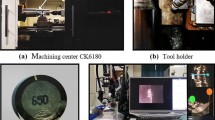Abstract
The aim of the present work is to develop a reliable method to predict tool wear precisely in a turning process by developing a mathematical model and comparing it with experimental results. Some important factors like cutting (chip-tool) interface temperature and three components of cutting forces as input variables and tool wear rate as an output variable have been used to develop the mathematical models. A set of experiments were performed on a commercial lathe without coolant. The experimental results show that there is an increase in three directional components of the cutting forces with increase in tool wear rate. Among the three components of cutting forces measured, the main cutting force (Thrust force) is the largest one while the radial force is the smallest. However, when the tool insert begins to fail, all the three cutting forces and chip-tool interface temperature increases sharply. The radial force was also found to be slightly larger than the feed force, when tool begins to fail. The mathematical models were solved by MATLAB software. To take into considerations these wears also, use of machining ratio as tool life criterion has been suggested.
Access this chapter
Tax calculation will be finalised at checkout
Purchases are for personal use only
Similar content being viewed by others
References
Kalpakjian S (2005) Manufacturing engineering and technology, Fourth edition, llanos Institute of Technology, pp 551–557
Rao P (2000) Manufacturing technology, metal cutting and machine tools, Tata McGraw-Hill Publishing Company Limited, New Delhi, pp 37–44
Noordin MY, Venkatesh VC, Sharif S (2007) Dry turning of tempered martensitic stainless steel tool steel using coated cermets and coated carbide tools. J Mater Process Technol 185:83–90
Chaudhary SK, Ramesh S (1995) On line tool wear sensing and compensation in turning. J Mater Process Technol 49:247–254
Luo X, Cheng K, Holt R, Liu X (2005) Modeling flank wear of carbide tool inserts in metal cutting. Wear 259:1235–1240
Ozel T, Karpat Y (2005) Predictive modeling of surface roughness and tool wear in hard turning using regression and neural networks. Int J Mach Tools Manuf 45:467–479
Ramesh S, Karunamoorthy L, Palnikumar K (2008) Surface roughness analysis in machining of titanium alloy. Mater Manuf Process 23:174–181
Felix Prasad C, Jayabal S, Natarajan U (2007) Optimization of tool wear in turning using Genetic algorithm. Indian J Eng Mater Sci 14:403–407
Al-Ahmari AMA (2007) Predictive machinability models for a selected hard material in turning operations. J Mater Process Technol 190:305–311
Anthony Xavior M, Adithan M (2009) Determining the influence of cutting fluids on tool wear and surface roughness during turning of AISI304 austenitic stainless steel. J Mater Process Technol 209:900–909
Noordin MY, Venketesh VC, Sharif S, Elating A (2004) Application of R.S.M. in describing the performance of coated carbide tools when turning AISI 1045 steel. J Manuf Process Technol 145:46–58
Huang Y, Chou YK, Liang SY (2007) CBN tool wear in hard turning: a survey on research progress. Int J Adv Manuf Technol 35:443–453
Braghini A, Coelho RT (2001) An investigation of the wear mechanisms of PCBN tools when end milling hardened steel at low/medium cutting speeds. Int J Adv Manuf Technol 17:244–257
Palanisamy P, Rajendran I, Shanmugasundaram S (2008) Prediction of tool wear using regression and ANN models in end-milling operation. Int J Adv Manuf Technol 37:29–41. https://doi.org/10.1007/s00170-007-0948-5
Tsao CC (2009) Grey-Taguchi method to optimize the milling parameters of aluminum alloy. Int J Adv Manuf Technol 40:41–48. https://doi.org/10.1007/s0017-007-1314-3
Abhang LB, Hameedullah M (2011) Empirical modeling of turning parameters using grey relational analysis. J Appl Mech Mater 110–116(2011):2596–2603
Author information
Authors and Affiliations
Corresponding author
Editor information
Editors and Affiliations
Rights and permissions
Copyright information
© 2018 Springer International Publishing AG, part of Springer Nature
About this paper
Cite this paper
Abhang, L.B., Hameedullah, M. (2018). Modeling and Analysis of Tool Wear Based on Cutting Force and Chip-Tool Interface Temperatures in Turning. In: Antony, K., Davim, J. (eds) Advanced Manufacturing and Materials Science. Lecture Notes on Multidisciplinary Industrial Engineering. Springer, Cham. https://doi.org/10.1007/978-3-319-76276-0_42
Download citation
DOI: https://doi.org/10.1007/978-3-319-76276-0_42
Published:
Publisher Name: Springer, Cham
Print ISBN: 978-3-319-76275-3
Online ISBN: 978-3-319-76276-0
eBook Packages: Chemistry and Materials ScienceChemistry and Material Science (R0)




